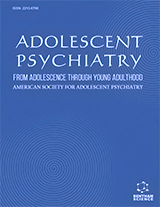Abstract
Adolescent immigrants need to navigate typical adolescent challenges while also struggling with the impact of immigration. Mastering the developmental tasks of adolescence is even more daunting for those teenagers who have underlying psychopathology. Intensive psychotherapy with these troubled teens provides a rich opportunity to better understand their struggles and to examine how best to provide necessary support for them. In this paper we explore how the task of engaging adolescents and their families warrants an approach that provides a space that is both flexible and responsive, addressing the underlying loss and behavior secondary to insecure or disorganized attachments. A case study of an immigrant teen in long-term treatment at a school-based health center (SBHC) highlights the importance of utilizing an attachment based model when intervening with this rewarding and highly vulnerable population. The case example illustrates the long term, therapeutic work which is reflective of the complicated patients in our caseloads, and also illuminates how the attachment framework shapes the therapeutic work. The advantages of the SBHC for utilizing this model are discussed.
Keywords: Adolescents, attachment, adolescent development, psychotherapy, immigrant adolescents, Asian adolescents, female adolescents, case report, school-based health center (SBHC), intersubjective dyad, albeit active, secure base seeking, separation/individuation, collectivist, sophomore, Mandarin-speaking therapist, matched' therapist, psychopharmacology, prognosis, countertransferential disappointment, jeopardizing, Mentalization
Adolescent Psychiatry
Title: “When Can I See You Again?”: The Immigration Experience, Insecure Attachment and Psychotherapy
Volume: 1 Issue: 1
Author(s): Anjana Rajan and Nancy Rappaport
Affiliation:
Keywords: Adolescents, attachment, adolescent development, psychotherapy, immigrant adolescents, Asian adolescents, female adolescents, case report, school-based health center (SBHC), intersubjective dyad, albeit active, secure base seeking, separation/individuation, collectivist, sophomore, Mandarin-speaking therapist, matched' therapist, psychopharmacology, prognosis, countertransferential disappointment, jeopardizing, Mentalization
Abstract: Adolescent immigrants need to navigate typical adolescent challenges while also struggling with the impact of immigration. Mastering the developmental tasks of adolescence is even more daunting for those teenagers who have underlying psychopathology. Intensive psychotherapy with these troubled teens provides a rich opportunity to better understand their struggles and to examine how best to provide necessary support for them. In this paper we explore how the task of engaging adolescents and their families warrants an approach that provides a space that is both flexible and responsive, addressing the underlying loss and behavior secondary to insecure or disorganized attachments. A case study of an immigrant teen in long-term treatment at a school-based health center (SBHC) highlights the importance of utilizing an attachment based model when intervening with this rewarding and highly vulnerable population. The case example illustrates the long term, therapeutic work which is reflective of the complicated patients in our caseloads, and also illuminates how the attachment framework shapes the therapeutic work. The advantages of the SBHC for utilizing this model are discussed.
Export Options
About this article
Cite this article as:
Rajan Anjana and Rappaport Nancy, “When Can I See You Again?”: The Immigration Experience, Insecure Attachment and Psychotherapy, Adolescent Psychiatry 2011; 1 (1) . https://dx.doi.org/10.2174/2210676611101010035
| DOI https://dx.doi.org/10.2174/2210676611101010035 |
Print ISSN 2210-6766 |
| Publisher Name Bentham Science Publisher |
Online ISSN 2210-6774 |
 18
18
- Author Guidelines
- Bentham Author Support Services (BASS)
- Graphical Abstracts
- Fabricating and Stating False Information
- Research Misconduct
- Post Publication Discussions and Corrections
- Publishing Ethics and Rectitude
- Increase Visibility of Your Article
- Archiving Policies
- Peer Review Workflow
- Order Your Article Before Print
- Promote Your Article
- Manuscript Transfer Facility
- Editorial Policies
- Allegations from Whistleblowers
- Announcements
Related Articles
-
Biological Effects of Curcumin and Its Role in Cancer Chemoprevention and Therapy
Anti-Cancer Agents in Medicinal Chemistry The Janus Face of CD4+CD25+ Regulatory T Cells in Cancer and Autoimmunity
Current Medicinal Chemistry 1, 4-Dihydropyridines: A Class of Pharmacologically Important Molecules
Mini-Reviews in Medicinal Chemistry Recent Advances in the Design and Synthesis of Prednisolone and Methylprednisolone Conjugates
Current Pharmaceutical Design Anti-dementia drugs-related changes in gait performance while single and dual tasking in patients with Alzheimer disease: a meta-analysis
Current Alzheimer Research Neurocognitive Functioning and Cannabis Use in Schizophrenia
Current Pharmaceutical Design Short-term High-Dose Effect of Lovastatin on Thrombolysis by rt-PA in a Human Whole-Blood in vitro Clot Model
Current Neurovascular Research Exploring QSAR of Flavonoids as Scavengers of Peroxynitrite Using Electrotopological State (E-State) Atom Parameter
Letters in Drug Design & Discovery Repetitive Transcranial Magnetic Stimulation Combined with Antidepressants for the First Episode of Major Depressive Disorder
Current Neuropharmacology Design, Synthesis and Characterization of Novel Urolithin Derivatives as Cholinesterase Inhibitor Agents
Letters in Drug Design & Discovery Neurokinin 3 (NK3) Receptor Modulators for the Treatment of Psychiatric Disorders
Recent Patents on CNS Drug Discovery (Discontinued) Recent Advances in Herbal Nanomedicines for Cancer Treatment
Current Molecular Pharmacology New Insights on the Xenobiotic-Sensing Nuclear Receptors in Liver Diseases – CAR and PXR-
Current Drug Metabolism Altering Outcomes in Juvenile Offending: The Evidence Base
Adolescent Psychiatry Endophytes and Neurodegenerative Diseases: A Hope in Desperation
CNS & Neurological Disorders - Drug Targets Panicogens in Patients with Post-Traumatic Stress Disorder (PTSD)
Current Pharmaceutical Design Advances in the Discovery of Novel Positive Allosteric Modulators of the α7 Nicotinic Acetylcholine Receptor
Recent Patents on CNS Drug Discovery (Discontinued) Alkaloids from Cyanobacteria with Diverse Powerful Bioactivities
Mini-Reviews in Medicinal Chemistry Evaluation of Salivary Antioxidants and Oxidative Stress Markers in Male Smokers
Combinatorial Chemistry & High Throughput Screening Nano-antimicrobials: A New Paradigm for Combating Mycobacterial Resistance
Current Pharmaceutical Design


























